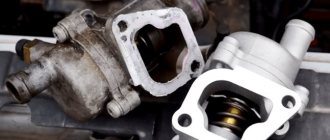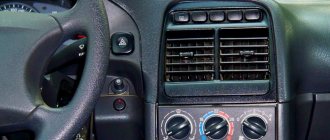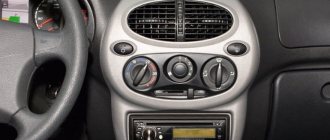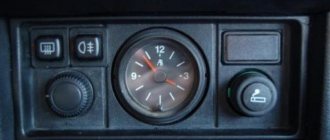Owners of VAZ 2114 cars sometimes encounter such a problem as a malfunctioning stove. This breakdown causes especially great inconvenience in winter: not only does it become cold in the cabin, but the windshield is also covered with an icy crust, blocking the view. If your VAZ 2114 stove also does not work, you must first find the cause of the malfunction. Why does the VAZ 2114 stove: does not heat well, does not heat, does not work?
Heating system VAZ 2114 - regulators
Problems with the interior heater can arise for various reasons, ranging from electrical wiring to wear and tear on the cooling system pump.
Next, we will look in detail at the main reasons for a non-functioning or poorly functioning stove, where you will find a solution to repair your heater. As a rule, all heating system malfunctions can be divided into two categories:
- Cold or slightly warm air is blowing from the air ducts.
- The heater does not turn on or does not work in all modes.
First, let's look at the reasons why the stove sometimes works worse or doesn't heat at all.
What is a stove and its functions
In the engine cooling system, the heater takes part of the heat, directing it into the car interior and maintaining the desired temperature there.
It is a whole chain of interconnected parts:
- Pipes.
- Stove radiator.
- Tap for adjusting the antifreeze level.
- Dampers with air ducts that control and direct air flow.
- Electric fan.
The combination of these elements ensures an uninterrupted supply of air to the car interior and maintains the desired temperature in it. What to do if the VAZ 2114 stove does not heat well, the stove has completely stopped working? We will indicate the main causes of the malfunction.
WE FIX THE PROBLEM OURSELVES
This also happens - at high speeds the stove “breaks through” and it starts to heat up, but at idle speed the fan blows cold air. Why doesn't the VAZ 2114 heater heat up at idle? We immediately note that if you are the owner of a VAZ 2113 or VAZ 2115, then all solutions to problems with the lack of heating of the interior will be similar to the solutions with the 2114 model. So, we are trying to find simple solutions to the problem ourselves:
- Insufficient coolant level. Add antifreeze; if the stove breaks, the problem is solved.
- Airlock. How to check? In the area of the heater radiator, the characteristic murmur of antifreeze is heard, the temperature sensor on the instrument panel shows almost maximum (almost boiling), one of the main radiator pipes is cold. You need to remove the expansion tank cap, press on the pipes and “gas” the engine. Perhaps the plug will break. It happens that the valve itself in the tank plug is to blame; you can try replacing it. It is also often advised to park the car on a hill, with the plug removed, “gas” the engine, and then add antifreeze when the plug “breaks”.
- Also, if one of the pipes is cold and the temperature on the sensor goes off scale, a faulty thermostat is to blame. It's easy to check. We remove and place the thermostat in a container of water, heat the water and see at what temperature the thermostat valve begins to close. It should open at engine operating temperature (90-95ºC). The faulty part needs to be replaced.
- The head gasket begins to burn out. With such a malfunction, an air lock is created in the cooling system, but it will not be possible to expel it using all known methods. The gasket will have to be changed. True, not every car enthusiast can do such work with his own hands.
Removing the thermostat
Cylinder head gasket
Sometimes the cause of the malfunction is hidden in a burnt-out cylinder block gasket.
Cylinder head gasket
You can determine whether the gasket is intact by these signs:
- Antifreeze smells like gasoline and contains exhaust gases.
- When the engine is running, white smoke comes out of the exhaust pipe.
- There is a light mixture on the dipstick and oil filler cap.
If at least one of these signs is detected, you need to urgently check the condition of the gasket and replace it if necessary, otherwise the problems will be much more serious.
Problem with switches
To test the heater switch, you need a simple 12-volt light bulb with two wires. It is necessary to remove the central part of the instrument panel and do the following:
1. Turn on the ignition; 2. We connect the negative contact of the light bulb to ground with a wire; 3. We connect the positive contact alternately to outputs 1-2-3 on the additional resistor.
If the light comes on, the switch is working properly. Otherwise, the problem may be a blown fuse or an open circuit. If only the third speed does not work, you need to replace the additional resistor.
Thermostat
When the stove on a VAZ 2114 does not heat well, the thermostat may be the cause. The valve does not open, which causes a disruption in the circulation of the coolant. The engine boils quickly, and the heater doesn't work well or doesn't work at all in winter. You need to check if the valve is working. With the engine warm, touch the upper and lower hoses of the main radiator; they should be hot.
Thermostat
If one of them is cold, the valve is faulty. Or remove the thermostat and heat it in a container of water. Before the water boils, the valve must open. Does not open, needs to be replaced with a new one. The thermostat is inexpensive. Experienced car enthusiasts advise changing them according to the time of year, guided by the fact that the colder it is outside, the lower the valve opening temperature.
Fuses and relays
Fuse box
One of the simplest and most unpleasant faults is a blown fuse. It is simple because anyone can replace a fuse, but it is unpleasant because it can be very difficult to determine why it blew. Typically, fuses blow due to a short circuit in the electrical wiring. On VAZ 2114 cars, the 30-amp fuse F7 is responsible for the heater, on which the cigarette lighter, glove compartment lighting, electric headlight washer motor and rear stack heating also depend. Accordingly, all this will not work together with the stove.
Radiator
The reason could be the radiator. Over time, its honeycombs become clogged with debris and dirt, causing the supply of warm air to become weak. In this case, the radiator is washed with appropriate solutions. It happens that honeycombs are damaged mechanically, which impairs the circulation of coolant.
Radiator for VAZ 2114
This radiator cannot be repaired. And you only need to buy new, not used. To replace, you must disassemble the front panel and console. Drain the antifreeze from the radiator through the tap into a container. Then remove the pipes from it and unscrew the fastening bolts. After installing a new one, fill in antifreeze. It is recommended to pour into the expansion tank in small portions to avoid the formation of air pockets. Fill 200-300 ml. You need to wait a few seconds and add more until the system is full.
Stove motor failure
Heater motor
The heater motor may burn out over time, but before you start replacing it, check all fuses, the ignition relay, and the heater temperature switch for integrity. If all this is in order, the problem is with the motor. It must be replaced by first disassembling and removing the dashboard. We described in detail how to do this above. You also need to remove antifreeze or antifreeze from the system and turn off the heater valve.
After removing all the pipes, pull out the old stove and install a new one in its place. After checking the performance of the heater, you can fill the cooling system with the previously drained liquid.
Airlock
Another reason why the 2114 heater does not heat well at idle may be airing in the system. After turning off the engine, air sometimes enters the radiator from the expansion tank and remains in the area of the thermostat. And the next time you start the engine, air will circulate instead of liquid. As a result, the engine heats up quickly and the heater does not work.
Air lock on VAZ 2114
To get rid of this trouble, loosen the coolant pipe clamp and slowly fill in antifreeze to the desired condition. It should be remembered that the liquid must be used of the same brand; mixing is strictly prohibited. You can try driving up a steep slope in front, remove the cap from the expansion tank and wait about 5 minutes. Usually the system itself pushes unnecessary air out.
What does the VAZ 2114 car heating system consist of?
Its details:
- Radiator.
- Special pipes with circulating liquid.
- A valve responsible for adjusting the optimal level of circulating fluid.
- Special dampers that control the air.
- Air duct.
- Electric fan.
When working properly, the air flow should move freely through all nodes of the above-described system.
Why the stove does not heat well on a VAZ 2114, or the stove either heats or does not heat, you will find out further.
Why does it blow cold on the windshield?
The supply of heated air in this location is regulated by a special damper. It is driven by a cable, which on a VAZ is generally stretched very often. This, in turn, leads to the fact that the damper itself does not open fully. In such a situation, air will be supplied inside the car directly from the street, that is, cold.
Understanding the principle by which heating functions in the VAZ-2114, it is generally not difficult to find out what the actual problem is. But even an experienced car enthusiast will need a lot of time to fix it. The thing is that the stove itself is located directly behind the panel located in the front of the cabin, near the steering wheel - troubleshooting requires its dismantling.
The problem with the cable is most noticeable when the temperature control is turned downward (that is, to the left).
Repairing heating in general is quite easy. You should proceed in this order:
- The cover under the steering wheel on the left is removed;
- the cable itself and its fastening are found near the gas pedal;
- the clamp is dismantled;
- the cable is tightened so that it does not sag;
- fixed with the same clamp;
- the damper control levers move (left to right all the way and vice versa);
- The tap regulator is set to maximum.
After this, the ignition is turned on and very soon fairly hot air begins to blow from the previously blocked holes. As practice shows, these manipulations help get rid of the problem in virtually all cases.
To eliminate this mess, you will need to remove the cable of the damper mentioned above from the heating regulator. This is done as follows:
- remove the cover on the right side of the steering column;
- the regulator drive is found there (it has 2 cables);
- the one to the right is unhooked;
- the dismantled cable is tensioned so that the damper moves to the position of maximum heating of the interior;
- the resulting excess piece is cut off after fixing it in the old place, with a margin of no more than one and a half centimeters.
After this, the stove should work fully, and adjusting the temperature will be easy and comfortable.
Lada 2114 Music is My Life. › Logbook › Stove 2114 does not heat up at idle
This is perhaps one of the very few posts not about car audio.
To be honest, I would even say this is a cry from the heart, so I will write a lot) The entry is dedicated, as the title suggests, to problems with the stove. And so, the point is that throughout the entire time I owned this car, which was about three years, I had one problem with the stove - IT WOULDN’T HEAT AT IDLE. I solved this problem just now! Because, to be honest, this really bothered me! Why did it take so much time to resolve, the question may arise? I will say this, because in fact, there are quite a lot of reasons for a stove that heats poorly, does not heat at all, or only heats while it is running, so it is difficult to get to the bottom of it right away. I read a LOT of forums on the Internet, including on the drive by the way) and a lot of reasons why this could be. And then I will write these reasons, and explain what symptoms were accompanied specifically by my problem, because this entry can help an unfortunate and desperate person like me, like me) I’ll start with the worst.
1. The cylinder head gasket has burned out or is starting to burn out. Let me say briefly, if it burns out, you will definitely not have time for the stove)) since it is antifreeze in oil or vice versa, blown pipes, clouds of blue smoke... in general, oh oh. BUT, while looking for a solution to the cause of my problem, I more than once came across records of people whose gaskets allegedly just started to burn out, and the symptoms are very similar. Everything seemed to be fine, but the stove had already stopped heating)) In general, in desperation, I decided to change that same gasket, and voila! Fuck there! everything remains as it was, so if none of the things listed below help you, then soon you will get money, but don’t rush into it))
2. Pump. A lot and most often they write that the problem is in a poorly pumping pump, they say it has either turned over there, or is worn out, or is simply acting up... the consequence is poor coolant circulation at idle, the stove does not heat, etc.... In general, IMHO, this is all complete crap and rave! since you probably already guessed, I changed it too. Result - 0! Why is this crap? You know, the pump either pumps or it leaks, and the car is boiling, well, and there is a consequence of the cylinder head gasket and all that stuff... there’s no other way! verified.
3. Heater radiator. I’ll say this, on a car with an identical problem they changed it, guess the result)) that’s right, it didn’t do anything)) Many people also write that it’s clogged, or it’s simply not of good quality in itself, etc... yes, undoubtedly, this is an option. BUT I’ll tell you this, you have to try very hard to clog the radiator. On the car where they changed it (in fact, that’s why they thought it was him), TWO tubes of sealant were poured into the system... it’s like it can clog the system)) but we opened the removed radiator)) and there were only a couple of trash cans) and nothing else)) From this I concluded that you need to make a specific effort to clog the radiator)) If it’s leaking, then no doubt, change it)) but if it’s dry... then it’s unlikely that’s the reason)) although who knows
4. Here I will write several reasons at once, so as not to prolong the writing) - air lock. it’s easy here)) we stood on a steep hill or overpass, opened the expander, accelerated), the fan worked, went out, close the lid. Did it help? you are lucky) but take your time, drive a little)) is the problem back? you are unhappy like me))) - expansion tank cap. Does not hold pressure, does not relieve pressure, poor coolant circulation, life pain, etc. costs 150r. try it)) if it helps, you're lucky. BUT its malfunction is accompanied by inadequate behavior of the temperature arrow, so...) see for yourself)
5. The stove tap is not fully open. well check)
IN GENERAL, I got all this from the Internet)) BUT I didn’t see the reason why I had problems anywhere!
It was the thermostat! Yes! But everyone I asked said, what does all this have to do with it? If it jams, then the car either boils or does not heat up at all, does it hold 90? Well then it’s definitely not him! Well, I believed it...) And I puzzled further. After all the options I tried, I didn't know what to think. you're standing there cold... you rev it up a little, then it's immediately hot... idk... poor circulation yes... but why? pump is ok! new! no air! The radiator is not clogged! but what else? I suggested that the thermostat might simply not be closing the large circle enough... and the car warms up... and stays at 90, but the circulation at idle turns out to be in the wrong direction, as they say, and in the wrong way (specifically, the bitch in the oven)) In general, it turned out to be so!)) happy and that's all))
Video “Reconstruction of the VAZ heating system”
This video explains how to make the cabin warmer and therefore more comfortable (the author of the video is Alex ZW).
Owners of domestic vehicles, for example, such as the VAZ 2114, periodically encounter a problem that appears in winter - the heater stops functioning properly. Problems may result in the fact that warm air stops coming from the stove or the motorist will not be able to turn on the heating unit at all. Therefore, in such a situation, when the windshield of a vehicle is covered with a layer of dense ice “blanket”, which obstructs normal visibility, the motorist must know how to act correctly at such a moment. In view of this, if problems arise with the heater, you must first understand the structure of the system and know the circuit diagram of the unit, which will help find the cause of the malfunction.
Replacement instructions
The radiator is a replaceable unit, so if it is faulty, it needs to be replaced.
The replacement procedure consists of the following steps:
- First of all, you need to drain the coolant.
- Next you need to dismantle the dashboard. You can remove not the entire tidy, but only part of it to get to the radiator. How to remove the panel is described in the operating instructions.
- Before replacing, it is necessary to disconnect all wires and hoses that go to the radiator.
- Then you need to unscrew the fasteners and dismantle the unit.
- The removed radiator must be cleaned if it is clogged. If it leaks, it needs to be changed. Assembly should be carried out in the reverse order (video author - VChSLV).
After the repair, the microclimate in the cabin will be restored and no frost will be scary.
Reasons for refusal
We have already noted that there may be several reasons for the heater not to work. Namely:
- Failed thermostat;
- Air lock formation;
- Broken heater tap;
- Clogged radiator;
- Radiator failure;
- Low pressure in the system;
- Lack of antifreeze;
- Burnt-out BC gasket;
- Failed electric motor.
Now let’s look at each of the presented breakdowns in more detail and figure out what needs to be done in a given situation.
Thermostat
To begin with, we recommend starting the engine and turning on all operating modes of the stove fan one by one. If there is no noise characteristic of a working heater, then repairs will have to begin.
A faulty thermostat is one of the most common problems. Because of this, the coolant that circulates through the circuit cannot cool properly. This causes the stove itself to fail.
Heater thermostat
Airlock
Air pockets appear when the engine is turned off. At that moment, the temperature of the coolant begins to decrease.
As a result, air leaks into the upper part of the radiator, which gradually passes into the thermostat. When the engine starts again, the pump drives the accumulated air into the radiator of the heating system. As a result, the stove does not heat the interior at all.
To get rid of the air lock, remove the pipes and gradually begin to fill in antifreeze. The tank should be topped up to the maximum level.
Broken tap
It is noteworthy that the heater valve often becomes the main and most common cause of a non-working interior heater. The faucet simply cannot open all the way. There are two reasons for this.
- The faucet is completely out of order and therefore must be replaced.
- The device does not work properly due to poor fixation or deformation of the heater cable. The latter is located near the pedal assembly. To eliminate the breakdown, simply tighten the cable using pliers.
If a leak is detected and there is no hot air supply, the faucet must be replaced. Damage is easily detected by greasy deposits on the glass and stains with the smell of antifreeze on the floor.
Clogged radiator
Your heater may not work at all if the radiator is clogged with all kinds of debris and dirt. In this case, there may be very little air flow from the ducts.
Option two:
- Clean the radiator;
- Replace the unit with a new one.
Faulty radiator
Many car owners simply do not pay attention to heater radiators until winter comes. And when, even at low air temperatures, the driver tries to turn on the heating, it turns out that the radiator is not working or is seeing its last days.
Such situations are often encountered by those who bought a car during the warm season and did not bother to check the condition of the radiator. There is only one way out of the situation - replacement.
Heater radiator
If you decide to do the work yourself, we strongly recommend watching the video instructions. This way you can understand how the stove is removed, how its individual elements or the main unit - the radiator - are replaced.
Low pressure in the system
If there is no proper level of pressure in the system, the stove will not be able to idle. The pump, that is, the pump, is responsible for creating pressure.
It is quite easy to determine that a heater malfunction is related to the pump. When the car moves, heat goes into the interior. This pump should be replaced with a new one.
Experts recommend using duralumin pumps, which are highly efficient and have a long service life. Focus on . They work well with the VAZ 2114.
Lack of antifreeze
Often the heater does not provide adequate heat to the interior for a more common reason - due to a lack of antifreeze in the tank.
To cope with this problem, simply add the missing amount of coolant.
Burnt head gasket
Malfunction of the stove can occur as a result of burnout of the cylinder head gasket.
A breakdown can be determined by several characteristic signs:
- The coolant has acquired an unpleasant odor of a mixture of gasoline and exhaust;
- The smell of engine oil has acquired the characteristic notes of coolant;
- White thick smoke comes out of the muffler.
If a burnt gasket is found, it must be replaced.
Broken motor
The electric motor, which is directly involved in the operation of the stove, often breaks or burns out. Replacement is not always the right decision.
It is quite possible that the motor has not burned out, but simply needs repair. Check if the heater temperature switches are working. Plus, make sure the ignition relay is working. Often the problem can be solved by replacing the faulty heater.
To do this, free it from the pipes, remove the old stove and install a new one. We are talking here so that you understand about changing the radiator.
Stove valve malfunction
All cars use a valve that shuts off the flow of coolant through the heater radiator. It is he who is controlled by the “heat - cold” switch on the center console in the cabin. For various reasons, the faucet may not open all the way. In this case, the stove does not heat up at idle speed, since not enough hot antifreeze enters the radiator.
The solution is simple - the faucet must be replaced. We advise you to choose high-quality spare parts, since cheap taps quickly fail and jam in the closed or open position.
Refinement of the pipe
When the air flow from the left deflector is too small, you can force its intensity. To do this, you need to insert a small (about 50 mm) fan into the pipe. A cooler used in computers is suitable for tuning.
First remove the deflector. Make a hole for the cooler and install it. Seal. Put the branch pipe with the fan in place. Restore electrical. An alternative is to connect the cooler directly to the heater contacts. In this case, it will only work when the ignition is on.
Properly carried out modernization will add warmth to the interior and save the owner of the VAZ 2114 from many problems.
How to replace a heater motor with your own hands?
Remove the trim on the driver's side. Then disconnect the black and blue wires of the motor. Unscrew the mass fastening. After this, open the hood and remove the windshield wiper wiring. Next, unscrew the fasteners of the wiper panel and remove the rubber seal. Then unscrew the four screws that secure the upper casing of the stove motor. Next, you need to pull the power wires through the seal. To get the engine itself, its housing must be divided in half. If you turn half of the housing together with the motor, you can get it out.
All that remains is to install the new motor in place of the old one, secure it and connect it to the system.











